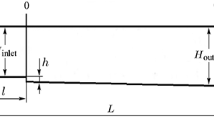Abstract
In order to develop a turbulent diffusion combustion model for supersonic flow, the physical argument of the extension of the flamelet model to supersonic flow was presented, and the flow field of a hydrogen/air diffusion combustion generated by axisymmetric supersonic jets was numerically simulated by employing the flamelet model. Using the experimental data, value of the model coefficient of scalar dissipation in the flamelet model was revised specifically for supersonic flow. The computational results of the modified flamelet model were compared with the experimental results, and it was indicated that the precision of the modified flamelet model was satisfying. Based on the numerical results and flamelet theory, the influence mechanisms of turbulence fluctuation on the average state equation and chemical reaction rate were studied for the first time. It was found that the fluctuation correlation of species mass fractions and temperature has little effect on the averaged gas state equation; the temperature fluctuation decreases the product of H2O, but its effect is small; the fluctuation of species mass fractions increases the product of H2O in the region close to oxidizer while decreases the product of H2O in other regions; the fluctuation correlation of species mass fractions and temperature largely decreases the product of H2O.
Similar content being viewed by others
References
Baurle R A. Modeling of high speed reacting flows: established practices and future challenges. AIAA 2004-267, 2004
Zhang H Q, Chen X L, Zhou L X, et al. A review on numerical modeling of turbulent combustion. Advan Mech, 1999, 29: 567–575
Zheng Z H. Massively parallel computing of dual-mode scramjet combustor and its experimental verification. Dissertation of Doctoral Degree. Changsha: National University of Defense Technology, 2003
Mitani T, Kouchi T. Flame structures and combustion efficiency computed for a Mach 6 scramjet engine. Combust Flame, 2005, 142: 187–196
Cheng T S, Wehrmeyer J A, Pitz R W. Raman measurement of mixing and finite-rate chemistry in a supersonic hydrogen-air diffusion flame. Combust Flame, 1994, 99: 157–173
Peters N. Laminar diffusion flamelet models in non-premixed turbulent combustion. Prog Energy Combust Sci, 1984, 10: 319–339
Ladeinde F. A critical review of scramjet combustion simulation. AIAA 2009-127, 2009
Xing J W. Application of chemical equilibrium and flamelet model for the numerical simulation of scramjet. Dissertation of Doctoral Degree. Mianyang: China Aerodynamics Research and Development Center, 2007
Overmann M. Numerical investigation hydrogen combustion in a scramjet using flamelet modeling. Aerosp Sci Technol, 2000, 4: 463–480
Linan A. The asymptotic structure of counterflow diffusion flames for large activation energies. Acta Astronaut, 1974, 1: 1007–1039
Libby P A, Williams F A. Turbulent combustion: fundamental aspects and a review. In: Libby P A, Williams F A, eds. Turbulent Reacting Flows. San Diego: Academic Press, 1994. 2–61
Swaminathan N, Bilger R W. Assessment of combustion submodels for turbulent nonpremixed hydrocarbon flames. Combust Flame, 1999, 116: 519–545
Peters N. Turbulent Combustion. Cambridge: Cambridge University Press, 2000
Tennekes H, Lumley J L. A First Course in Turbulence. Cambridge MA: MIT Press, 1974
Balakrishnan G, Williams F A. Turbulemt combustion regimes for hypersonic propulsion employing hydrogen/air diffusion flames. J Propul Power, 1993, 10(3): 434–436
Bray K N C, Libby P A, Williams F A. High speed turbulent combustion. In: Libby P A, Williams F A, eds. Turbulent Reacting Flows. San Diego: Academic Press, 1994
Waidmann W, Alff F, Bohm M, et al. Supersonic combustion of hydrogen/ air in a SCRAMJET combustion chamber. Space Technol, 1995, 15(6): 421–429
Gao Z X, Lee C H. A numerical study of turbulent combustion characteristics in a combustion chamber of a scramjet engine. Sci China Tech Sci, 2010, 53: 2111–2121
Menter F R. Two-equation eddy-viscosity turbulence models for engineering applications. AIAA J, 1994, 32(8): 1598–1605
James L B. Turbulence model validation for hypersonic flows. AIAA 2002-3308, 2002
Roe P L. Approximate Riemann solvers, parameter vectors and difference schemes. J Comput Phys, 1981, 43: 357–372
Kee R J, Rupley F M, Miller J A. The Chemkin Thermodynamic Data Base. Sandia Report SAND87-8215B, 1994
Spiegler E, Wolfshtein M, Manheimer-Timmat Y. A model of unmixedness for turbulent reacting flows. Acta Astronaut, 1976, 3: 265–280
Zhang M Y. Numerical simulation research of scramjet’s combustion chamber. Dissertation for master degree. Beijing: Beihang University, 2008. 29–34
Chang C T, Marek C J. Comparison of reacting and non-reacting shear layers at a high subsonic mach number. AIAA 93-2381, 1993
Author information
Authors and Affiliations
Corresponding author
Rights and permissions
About this article
Cite this article
Gao, Z., Lee, C. A flamelet model for turbulent diffusion combustion in supersonic flow. Sci. China Technol. Sci. 53, 3379–3388 (2010). https://doi.org/10.1007/s11431-010-4169-z
Received:
Accepted:
Published:
Issue Date:
DOI: https://doi.org/10.1007/s11431-010-4169-z




